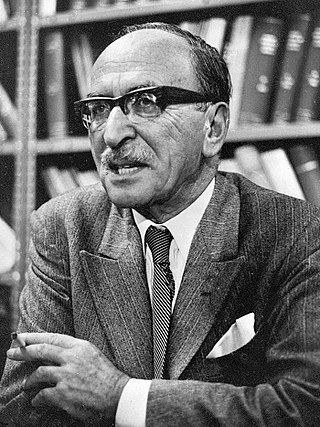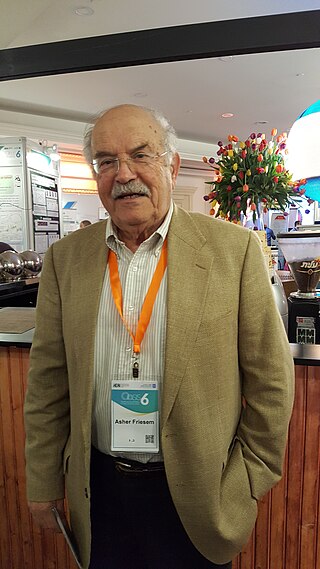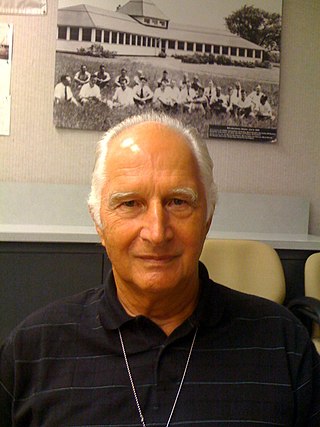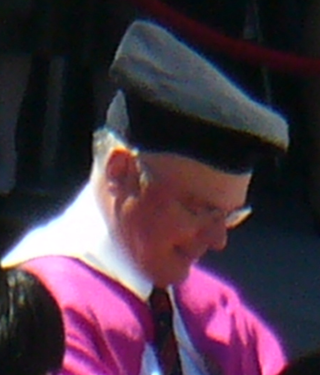
Holography is a technique that enables a wavefront to be recorded and later reconstructed. It is best known as a method of generating three-dimensional images, and has a wide range of other uses, including data storage, microscopy, and interferometry. In principle, it is possible to make a hologram for any type of wave.

Dennis Gabor was a Hungarian-British physicist who received the Nobel Prize in Physics in 1971 for his invention of holography. He obtained British citizenship in 1946 and spent most of his life in England.

Emmett Norman Leith was a professor of electrical engineering at the University of Michigan and, with Juris Upatnieks of the University of Michigan, the co-inventor of three-dimensional holography.

The Environmental Research Institute of Michigan (ERIM) was a research institute at Ann Arbor, Michigan, founded in 1972. The institute contributed to the development of remote sensing, radar, and holography. ERIM grew out of a military and environmental research arm of the University of Michigan, the Michigan Aeronautical Research Center, later known as the Willow Run Research Center.

Stephen Anthony Benton was the inventor of the rainbow hologram and a pioneer in medical imaging and fine arts holography. Benton held 14 patents in optical physics and photography, and taught media arts and sciences at Massachusetts Institute of Technology (MIT). He was the E. Rudge ('48) and Nancy Allen Professor of Media & Sciences, and the Director for Center for Advanced Visual Studies (CAVS) at MIT.
Fawwaz T. Ulaby is Arthur F. Thurnau Professor of Electrical Engineering and Computer Science at the University of Michigan in Ann Arbor and formerly the Founding Provost and Executive Vice President of the King Abdullah University of Science and Technology (KAUST) and R. Jamieson and Betty Williams Professor of Electrical Engineering and Computer Science at the University of Michigan.

Asher A. Friesem is a professor at the Weizmann Institute of Science in Israel.

Min Gu is a Chinese-Australian physicist who currently serves as the Executive Chancellor and Professor at the University of Shanghai for Science and Technology. Previously he was Distinguished Professor and Associate Deputy Vice-Chancellor for Research Innovation & Entrepreneurship at RMIT University.
Joseph Wilfred Goodman is an American electrical engineer and physicist.

Robert Louis Byer is a physicist. He was president of the Optical Society of America in 1994 and of the American Physical Society in 2012.

John Donovan Strong (1905-1992) was an American physicist and astronomer. One of the world's foremost optical scientists of his day, Strong was known for being the first to detect water vapor in the atmosphere of Venus and for developing a number of innovations in optical devices, ranging from improved telescope mirrors to anti-reflective coatings for optical elements and diffraction gratings.
Rod C. Alferness was president of The Optical Society in 2008.

Amnon Yariv is an Israeli-American professor of applied physics and electrical engineering at Caltech, known for innovations in optoelectronics. Yariv obtained his B.S., M.S. and PhD. in electrical engineering from University of California, Berkeley in 1954, 1956 and 1958, respectively.
Demetri Psaltis is a Greek-American electrical engineer who was the Dean of the School of Engineering at École Polytechnique Fédérale de Lausanne from 2007 to 2017. Since 2024 he is a professor emeritus at EPFL. He is one of the founders of the term and the field of optofluidics. He is also well known for his past work in holography, especially with regards to optical computing, holographic data storage, and neural networks. He is an author of over 1100 publications, contributed more than 20 book chapters, invented more than 50 patents, and currently has a h-index of 105.

Herwig Kogelnik is an Austrian-American electrical and optical engineer. He is best known for his fundamental contributions to the developments in laser technology, optoelectronics, photonics and lightwave communications systems. His work over a 40-year career at Bell Labs earned him the Marconi Prize, the IEEE Medal of Honor, the National Medal of Technology and many other awards.

David A. B. Miller is the W. M. Keck Foundation Professor of Electrical Engineering at Stanford University, where he is also a professor of Applied Physics by courtesy. His research interests include the use of optics in switching, interconnection, communications, computing, and sensing systems, physics and applications of quantum well optics and optoelectronics, and fundamental features and limits for optics and nanophotonics in communications and information processing.
Byoungho Lee was a South Korean scientist best known for his work on three-dimensional displays and nanophotonics. From 1994 until his death, he was on the faculty of the School of Electrical and Computer Engineering of Seoul National University. He and his research group published more than 400 peer-reviewed international journal papers, more than 700 international conference papers, and more than 20 books and book chapters. His accumulated citations are over 23,000 and his h-index is 75. At the time of his death, he was the dean of the Engineering College of Seoul National University.
The R. W. Wood Prize is an award endowed by Xerox and given by Optica to an individual that makes an outstanding technical contribution or an invention in the field of optics. The award was established in 1975 in commemoration of Robert W. Wood.

Joseph Rosen is the Benjamin H. Swig Professor in Optoelectronics at the School of Electrical & Computer Engineering of Ben-Gurion University of the Negev, Israel.

James Ray Fienup is an American optical scientist and applied physicist. He is the Robert E. Hopkins Professor of Optics at the Institute of Optics of the University of Rochester, where he researches imaging science. Fienup was the editor-in-chief of the Journal of the Optical Society of America from 1998 to 2003.














